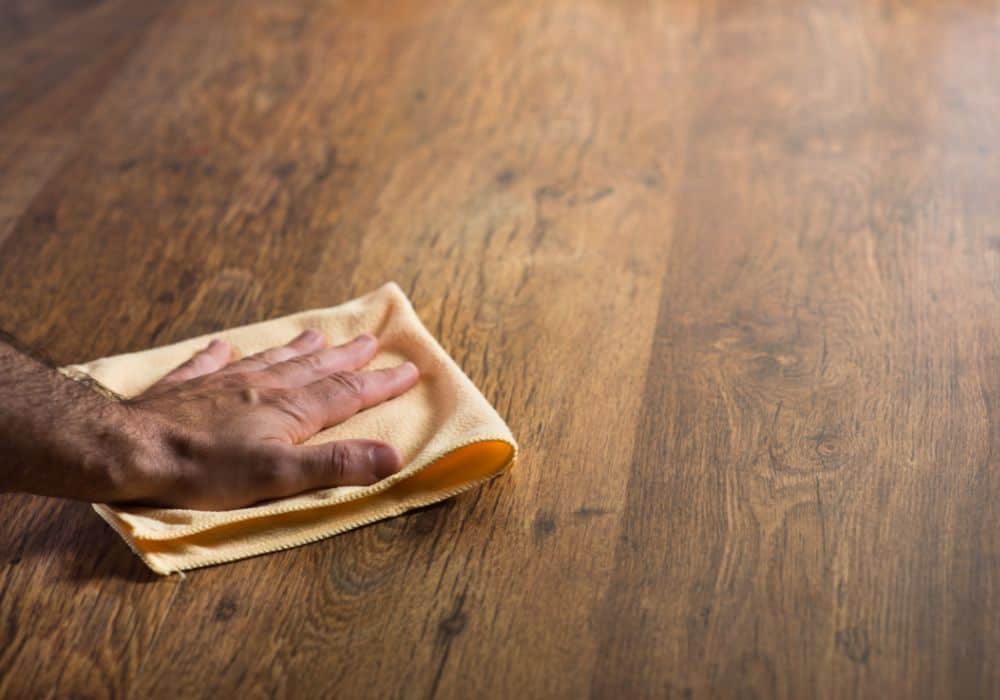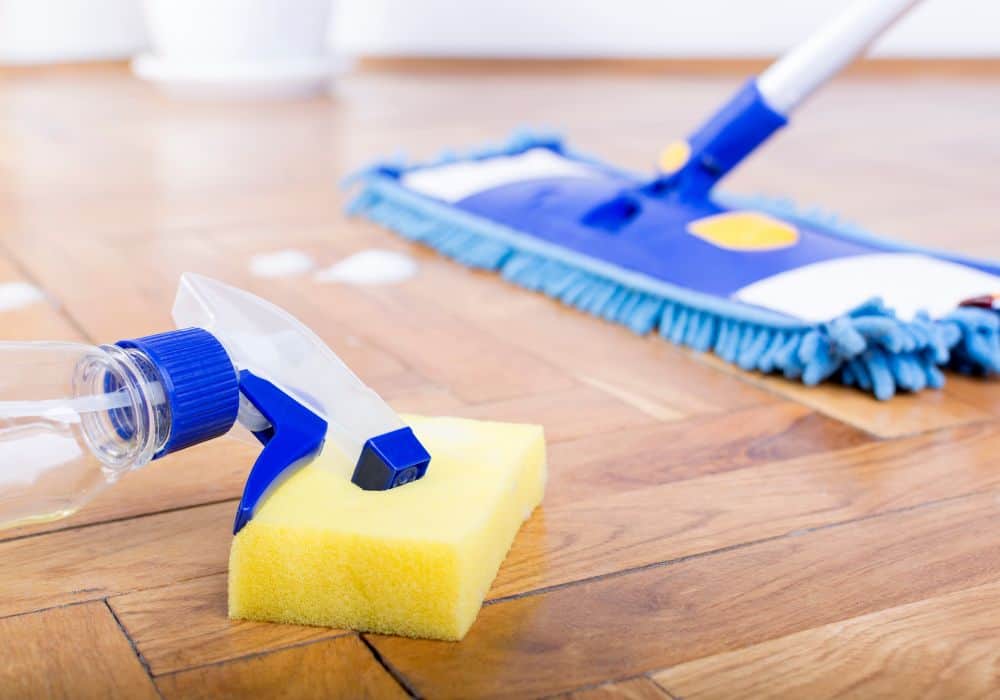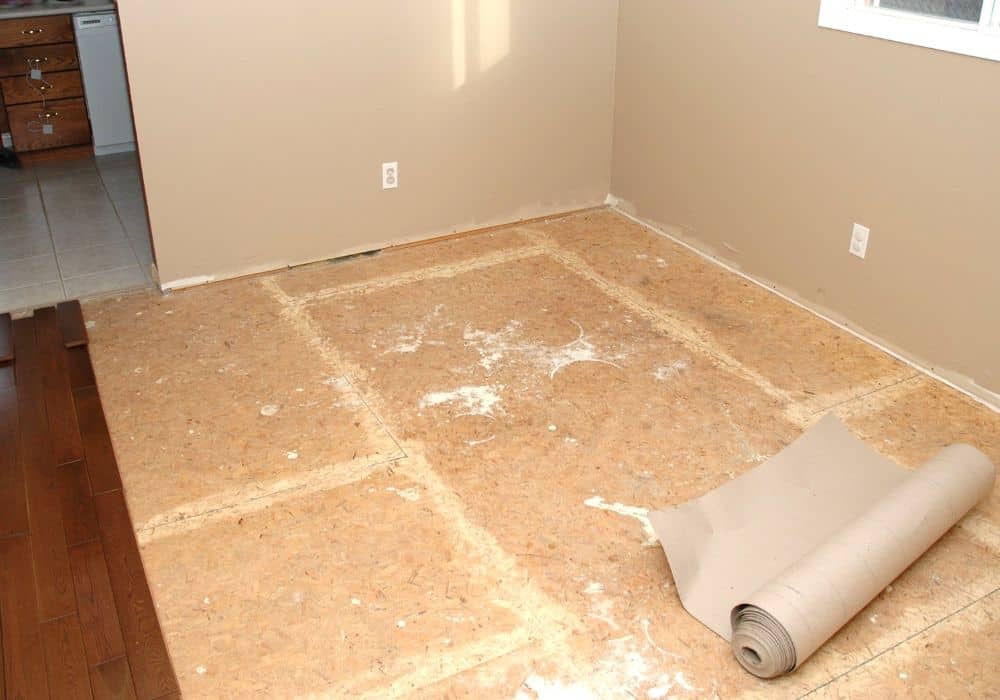Whether you’re painting your walls or doing arts and crafts with the kids, accidents happen. And sometimes, paint falls on top of our expensive hardwood floors. We immediately start to panic.
Although you might try to clean the mess up as it happens, quick-drying paint can set in, stain your floor and be pretty hard to shift.
But before you reach for the phone to hire a professional, what if we told you that you could remove pesky paint from your floorboards by yourself? And you don’t need any experience or expensive equipment, either!
This article will show how easy removing paint from your wood floors is. We’ll explore various common methods, including homemade remedies and commercial cleaners, and explain how to use them – your floors will be paint-free in no time.
Table of Contents
Firstly, what type of paint is on your floor?
First, you must determine what kind of paint you’re dealing with. Depending on whether it’s water-based paint or oil-based paint, you may need specific cleaning solutions or to alter your methods.
So how do you work this out?
You can perform a simple test if you don’t know from the paint’s tin. Grab a cotton ball and dip it gently into some running alcohol.
Rub the cotton ball across the paint stain, then examine it closely. If any paint residue is stuck to the cotton, you are dealing with water-based paint. If no residues exist on the cotton ball, it’s oil-based.
Step-by-step on removing paint from floors
1. Water-based paint
The trick is in the name – water-based paints can be removed by using soapy water. If the paint has dried and left for an extended period, it may have sunk into the wood and require multiple attempts to remove it fully.
- Mix warm water with dishwashing soap until you create a frothy solution.
- Dip a clean cloth into the solution and apply generously to the paint stain.
- If the paint is still relatively wet, it should wipe off almost immediately. If the paint has dried, you may need to scrub at the stain to dislodge it repeatedly.
- Repeat using clean rags to ensure you take as much paint as possible. Continue until the paint layer has been entirely removed.
- Soak up any excess water from the area and pat dry.
2. Latex paints
Similarly, latex paints are water soluble, meaning they often dissolve once you rub water into them.
However, latex paint can be much harder to shift, especially if thoroughly dried. You might need to apply more pressure, apply several applications, or instead of dishwashing soap, use other household items like lemon juice and rubbing alcohol.
- Try to scrape off as much dried paint as possible with cardboard. Consider using a rigid plastic putty knife for stubborn paint stains.
- Add 1 part lemon juice to 2 parts rubbing alcohol in a bucket, and mix until the agents have blended.
- Dip a cotton ball into the mixture and gently rub it against the paint stains.
- The lemon juice and rubbing alcohol will gradually soften and loosen the paint, allowing it to be removed more easily.
- If the paint has seeped deep into the wood, you might consider using an old toothbrush or scrub brush to apply extra pressure on the area.
3. Oil-based paints
Oil-based paints are often more durable, resilient, and resistant than water-based paints. That’s good news if you’ve painted your walls and doors, but bad news if it’s an unwanted stain!
While there’s no harm in trying the previous method of lemon juice and rubbing alcohol, you’ll likely need commercial paint removers.
You can use two products: a paint thinner or a paint stripper. A paint thinner can only be used if the oil paint is still dry – otherwise, we recommend using a stripper.
- Paint stripper method:
A paint stripper is a highly effective way of removing the oldest stains from hardwood floors. It effectively treats floorboards with unique moldings, shapes, designs, or crevices where paint has seeped.
- Ensure you’re working in an open, well-ventilated room and are wearing protective clothing, including eyewear and rubber gloves.
- Shake the paint stripper container to mix the contents. Then, pour a tiny amount of solution into a plastic container.
- Dip the corner of your cloth into the container, and apply carefully to a small section of the paint – this allows you to test it to see if you can get the desired reaction.
- Allow the section to dry for between 45 minutes to 1 hour. You can rub the small area of paint away with a scraper as soon as it has started to bubble.
- With a paintbrush, apply a generous layer of stripper over the entire paint in an even coat. Again, wait for a short period until the stripper dries. The paint should ripple and buckle off the floor.
- You may need to reapply several additional coats if the stains are severe. Use a pull scraper to remove stubborn stains, and collect the chippings with a vacuum cleaner. Keep your gloves on throughout the cleanup process as the stripper solution remains.
- Paint thinner method:
Thinners like mineral spirits, acetone, or turpentine, are often seen as a last resort for removing stains. This is because they are powerful solutions that can pose health risks as well as damage your flooring.
- Ensure your room is well-ventilated and you wear a mask during this task. Paint thinners release vapors that can cause lightheadedness and nausea.
- Dip a clean cloth slowly into the solution. Be careful not to soak it; too much thinner can damage the floor’s surface and ruin its finishings.
- Gently rub the cloth against the paint stain. This dilutes the paint, making it easier to remove. Allow the area to dry for about 20 minutes.
- Afterward, rub the dislodged paint from the area with a damp paper towel or paint scraper. Ensure you’re wearing gloves, as there may still be traces of the thinner on your floorboards.
- Afterward, inspect the area again, and repeat the process for any remaining stains.
Other methods to try:
Heat gun or hairdryer
Heat can be a speedy, easy, and relatively safe way to remove old paint stains. Aim the heat directly onto the stain using a heat gun (or a household hairdryer on a high setting).
The paint will eventually bubble, pressing itself off the wood. Then, use a plastic scraper to wipe away any excess paint.
Sander
Sanding paint down can be a quick, effective way to remove the most troubling stains, especially if you have an electric sander at home.
But it should be seen as a last resort, as it has the potential to damage flooring if you overdo it.
You should start with 60-grit sandpaper first to remove most of the surface paint in the area. Afterward, switch to 80 or 120-grit sandpaper to smooth out and buff the surrounding area.
How much does removing paint from flooring cost?
While this ultimately depends on the stains’ size and severity, you can expect to pay $1.32 per square foot if doing the job yourself. If you hire a professional, this figure jumps to around $10.30 per square foot, which includes materials and labor.
Expert Tips
- Before removing paint spills and stains, remember to remove the surrounding furniture from the area. Open windows to properly ventilate the room.
- Use the cotton ball trick to find the type of paint you’re working with.
- Always wear protective clothing, especially using chemicals, paint strippers, solvents, or DIY tools like sanders. Not only will clothing protect you from wood chips, but toxic fumes can irritate your eyes.
- Remember to change your damp rag when rubbing water-based paints frequently. The fabric can absorb everything from dust and dirt to excess paint.
- Cleansing pads are an abrasive cleaning material that can be highly effective at resistant stains.
- If you remove paint only to apply a fresh coat or stain, use grit sandpaper to smooth over the surface of the floor.
Conclusion
Whether it’s a pool, a splash, or a sprinkle, paint stains can be a nightmare on hardwood flooring. And many homeowners often worry that by trying to remove it yourself, you will only make things worse.
This article has shown how easy, practical, and cost-effective it can be to remove the paint yourself. No need to call a professional just yet!
The first step is working out what kind of paint you’re dealing with. Water and latex-based stains can often be shifted easily with simple household solutions of water, lemon juice, and rubbing alcohol.
But oil-based paints are a little trickier and may require some muscle, and a DIY tool, like a sander, to properly remove the stains.
Please comment below if you still have questions about removing troublesome paint from your hardwood flooring.
But when in doubt, remember:
- Sprinkle water on the stain and run a cotton ball over it. If paint sticks to the cotton, it’s water-based. If not, it’s oil-based.
- Try to remove the paint as soon as possible; not only will it be easier to remove when wet, but it will be less likely to stain your wooden floors permanently.
- If using solvents or sanders, wear protective clothing (including eyewear and a mask) before, during, and after to protect yourself from flying paint chips and toxic fumes.


